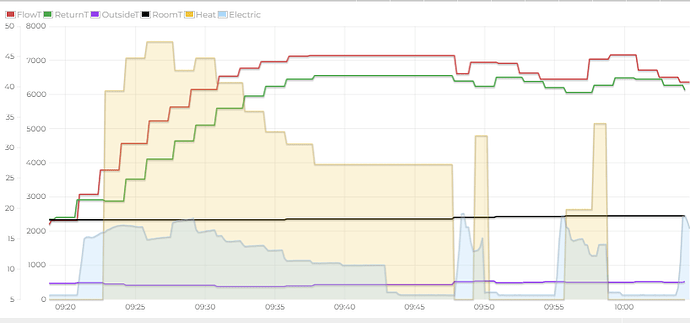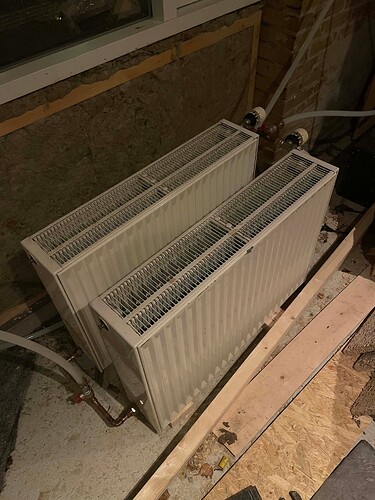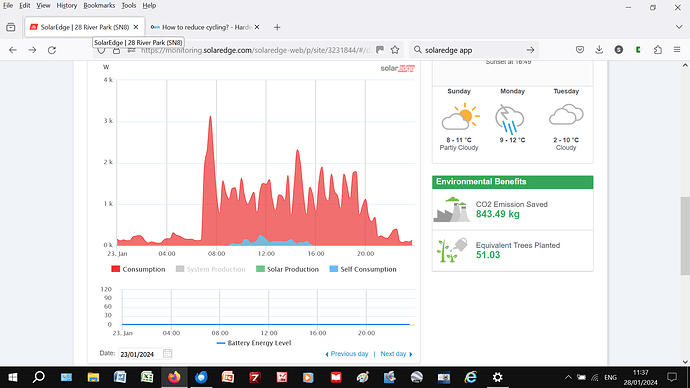ok so that’s odd. double check: they set 4051 to 2 (70%) and you set it back to 1 (100%) and that , and that alone, made a measurable improvement to heat reaching all parts of your system??
that implies that you DO have a PWM controlled pump.
it also suggests to me you need to get your installers to check that your pipework is properly laid out and the radiators are balanced. you should be able to get flow to all radiators even at lower flow rates, in a properly balanced system. if some radiators are “dropping out” of the circuit at lower flow rates, then that will reduce the effective emitter area , which is a potential cause of some of the problems you are seeing.
ok. in that case, if the PWM duty is at 100%, the flow rate should be constant, at the maximum your water circuit can deliver. The only reason that the flow rate can change, is if the water circuit changes: something opens or closes that makes the passage of water easier or harder.
i.e. a TRV on a radiator, or a zone valve (is an extra zone opening?) or a bypass valve?
Arne, a PS to Ian’s excellent summary:
My circulating pump is not PWM controlled, yet sometimes I see “Inverter Pump” MIM display as low as 90%. I think that this is simply what PWM signal the MIM would put out, were the pump PWM-enabled. My circulating flow does vary, though (18-24 l/min) as some radiator TRV demand changes. [My circulation piping has a shallow system curve, so a small change in pressure loss causes a big change in the intersection with the (almost horizontal) pump flow characteristic curve.]
Sarah
Hi @SarahH and @Ian_Calderbank
I will monitor the flow over the next few days. I ahve the Danfoss living (Used it when I had GAS) and those valves have been replaced by RA-G valves, 2,5 more flow than the old RA-N.
On top I have all valves wide open, no one is adjusted by heat in the room (All set to 28 degC, and we have around 21-22). Why, because I have adjusted the Radiators in those room where it was a bit cold to large ones, so it fits fine and we have allmost stable temps across all rooms - so far so good ![]()
I will try to search the system for possible faults, and I have my eyes on the Bypass that the installer mounted last time they were here…
thanks Sarah and Ian for your reply here - I really learn suff every day ![]()
This is a very interesting read. I have a daikin heatpump and have been playing with different ideas to reducing the cycling of my heatpump, maximise its efficiency and get the max COP.
My house is very well insulated and I find mine kicking in and when the delta T between flow and return is <2oC it stops the compressor but the circulator continues to run untill the detla t is at >4oC then kicks the compressor back in.
One idea is to fit fans to the bottom the rads and switch them on via home assistant to force the convection and keep that delta t at 4oC.
Another idea- maybe already mentioned is if your heatpump termostat SP is 20oC, is raise it by 1 or 2 degrees then lower again afterwards. I purchases a MOES zigbee thermostat so can change the SP on the fly via HA. However this then becomes a two step control.
My geek project for this winter is to install a PWM control grundfos circulator and write some code to vary the flow throught the system to keep the delta T at that sweet spot when the compressor is running at it lowest power and heat loss = heat input. That why max COP is achived.
This is how mine is running atm
Be intersted to know how other people get around this.
I will post an update when I get around to tinkering with this.
cheers
Gareth
Hi
We have had a temperature drop from around 4-5 degC to -5 degC ine the past few days.
Gave me the oppertunity to monitor a little at low temps.
And I must say, I really dont get this controllers logic - I have measured the following that flow is down to 12-13 l/min (Inverter said 59-64%) and powerconsumption at 1,6-1,9 kw
I have no idea why the flow have dropped and the it uses alot of power instead of keeping the higher flow, which I had at +5 degC (See: this post Samsung Gen 6 8kW Efficiency - #55 by Madsen68)
Outdoortemperatur: -5,8
Kl. 7.42: 13,1 l/min(64%) – 1,9 kw – 43,14 – 38,83 – Dt: 4,34 = 2,09 CoP = 3,971 kw heat produced
Kl. 7.46: 12,1 i/min(59%) – 1,6 kw – 43,34 – 38,69 – Dt: 4,71 = 2,46 CoP = 3,936 kw heat produced
Been into selftest to see temps there – after that, system started again, but now at full inverter pump speed at 100% - around 19,2 l/min
Kl. 7.58: 19,2 l/min(100%) – 1,4 kw – 40,72 – 37,29 – Dt: 3,42 = 3,29 CoP = 4,606 kw heat produced
Maybe there are an explanation for this?
Hi Gareth, very interesting data.
I’m no expert (especially Daikins) but it looks to me like you have the classic oversized ASHP, and (like me) you have your weather compensator set quite high, and don’t run your system 24/7.
You only give an hour’s data but it looks like your compressor is working hard for the first 20 minutes to heat up your circulating fluid/radiators, then slowly reduces speed as you reach WC setpoint, till at 9.48 (because ambient temp rises slightly) your LWT is too high even at minimum compressor speed, so it switches off. Your LWT then falls below WC setpoint then it starts again, and starts cycling every 10 minutes (at least to start with). It doesn’t look like your roomstat plays much part in the process, only the WC algorithm.
Classical advice would be to reduce your WC setpoint (which saves energy during the initial spike anyway), and run your radiators cooler (the lower LWT will always improve your CoP). However I’m not yet convinced that this would reduce cycling frequency, and would look at increasing my circulating inventory, i.e. increasing the size of your “flywheel”. My cycling is about twice an hour with a circulation of 20 litre/min and a 100 litre inventory. What are your figures?
Sarah
you have a PWM controlled pump. Once it gets beyond the initial period at the start of a cycle and something approaching a steady state is beginning to be reached, the controller reduces the flow rate in order to maintain the target DT. which will be 5 by default. So if the actual DT is less than 5 (its 4 in your case), the controller will slow the flow rate down as much as it can in order to try to increase the actual DT to the target (5). If you want it to slow down less, you set a lower target DT in the FSV 5052.
I have done this myself on my system (I’ve reduced target DT to 4) and it has made it more stable.
the higher power is because you have a higher flow temp in cold weather, because of your Water Law settings. You are running 43C flow temperature at -5C outside, yes? without checking the actual system data sheet, 1.6kw of electrical power to me seems like its probably reasonable power input to achieve that.
I think you’ve said your house is very well insulated so maybe you can run with a lower water temperature?
HA controlled fans under radiators - yes, done that. 10x 120mm 12v PC fans in a diy built string. cheap solution. controlled by an ESP32 from HA. Makes a measurable difference to heat output. but I only do this in the locations where the rads need a “bit of a boost”. fitting to every rad (I have 18) would be overkill and messy. Similar thing to override - force the fan on - in a pair of hydronic kitchen plinths, in this case an ESP32 controlled 230v relay .
PWM circulator - check if your heat pump can natively drive a PWM signal to a circulating pump to maintain DT. it might well be able to. If not, you can buy circulating pumps that will maintain a target DT for your.
Hi Arne, I was going to say something similar to Ian but he beat me to it ![]() .
.
Two things:
- Samsung data for -5.8degC ambient and 43degC LWT would give duty = 8.05kW, power = 2.81kW at 100% compressor speed, hence CoP = 2.86. So you appear to be running at minimum speed (both your duty and power are about half of the 100% figures). Your CoPs are not that far from the Samsung figures (try the average of your 7.46 and 7.58 figures…!).
- Be aware that the readings on the MIM display are subject to some time lag/refresh rate effects, especially the power reading. (I’m not sure where you are getting your data from, but when I use the MIM data for my calcs I find myself having to smooth the instantaneous numbers with a running average, to get rid of the “noise”.)
BTW Ian meant FSV 4052, not 5052!
Sarah
@SarahH thanks for the correction… I quickly looked up the FSV value then typed it wrong!
@Madsen68 It seems to me that the very cold weather you have right now might actually be just about cold enough for your oversized heat pump to run stably without cycling. I’m making a leap of reasoning, because you don’t have a nice long duration frequently sampled log, only 3 sample points, but what might be happening is that it got through the initial part of cycle (100% flow rate), and it is trying to get into to the stabilised long part of the cycle (which is good - thats where you want it to stay). The reduction in flow rate and reduction of pump duty % is a clear sign of that. I have seen exactly this with mine : during the stable part of the cycle it will try to reduce the flow rate to try to get the DT to widen to 5 . The issue I saw was that this means the flow rate always bumps against the 12l/min system minimum - causing it to frequently go round a reset loop of flow all the way back to max (100% water pump speed). you might be getting the same. Suggest you try FSV 4052 = 4.
I can REALLY recommend the benefits of installing something that logs your data continuously. it makes this troubleshooting and tuning so much easier. In your case you have the heatmeter already so half the work is done.
Hi Ian
I have reduced mine to 4 in target dt - and yes, correct, very well insulated - all though the past days have been a bit cold in especially one room, have a very small radiator there 60x55 cm. 2-layer. I have bought a new 90 x 90 3-layer to get more haet in there. Only 16-17 degC - which is damn cold during a bath ![]()
After that I might be able to lower the flow temp a bit - and might even get a little more difference in dt because og more heat is set into that room - look forward to see if the difference is noticable.
I also have another project - getting 2 x radiators set up in my garage - here is about 1-3 degC currently and I have 3 - layers in 60 x 80 cm. that will be ready at the end of this week, so this might be a gamechanger for this installation.
Thanks ![]()
PS: I will save some money, for the emoncms, when I get some guitars sold… ![]()
Hi Sarah
I know this is with lag on the Power read out, but I believe it is between 15 to 20 seconds ish ![]()
Thanks of the correct FSV - just made the change to 4 ![]()
Will add larger/more radiators to my system the next days, hope for better heat delivery, and better conditions for the ASHP ![]()
Radiators in your garage?? ![]() You obviously love your car more than I do mine.
You obviously love your car more than I do mine.
Let us know what happens when you try the new FSV 4052…
Sarah
Hi @SarahH and @Ian_Calderbank etc.
First change FSV 4052 to 4, did not do anything, or at least I was not able to see any significant change in behaviour.
I do love my car, but its more like a workshop for my guitar building, which really needs some heat in there - I was down to 1,4 degC, the other day…
So I installed, 2 Type 33 heaters just for test (See picture)
I just wanted to “produce” cold return flow to the ASHP, and I succeded, allthough it is still early in the test. Workshop is not completely closed so the cold can easily penetrate so it is real hard to get warm in there and make it a real reliable test… (Insulation will be done during the summer)
These 2 have since I installed them yesterday, raised the temp. from 1,8 degC to 9,8 degC.
Since 00:00 until now it have the following readings in the display of the ASHP:
Usage kwh: 15,7
Production kwh: 72,2
COP: 4,59
Outside temp. median: 1,8
To compare I here have readings of the full 24 hour of Jan. 3.
Usage kwh: 22,4
Production kwh: 61,4
COP: 2,74
Outside temp. median: 1,8
SO - I managed (for now) to push the ASHP to produce more heat in Kwh and use less kwh. (Less money spent - yeahhhhh)
The good thing here is that these Radiators are a bit to small (According to my calc. for the size of that workhop size at 32m2) but still eneough to get the flow going and eliminate the cycling.
Real cop reading during today have been between 4,6 and all the way up to 7,08 - so really quite a difference.
This works for now, and I guess a large buffer can extend that gap, so it will be more stable and avoid cycling at higher outside temperatures, at least that is what I aim for - a 300 L. buffer together with Radiators in my workshop that fits the needed heat demand in there. Not 100% sure, but my calculations tells me I need around 2500 watt at Flow 45/35, so quite big radiators in there.
If there are anybody, that have an excel sheet to calculate radiators heat demand/Size - let me know ![]()
Thanks. ![]()
Hi Arne, that sounds great news ![]() .
.
If you have the radiator vendor’s rating (e.g. 2200W @ 50degC deltaT for a 0.72m2 radiator, i.e. U = 61W/m/degC) then you can estimate output at other deltaTs from
Q = Vendor rating * (act deltaT / vendor deltaT) ^ 1.3 where deltaT is (radiator temp - room temp).
Very straightforward to put into a little spreadsheet. (If you don’t have vendor values, then the above U value 60W/m2/degC is reasonable for Type 22s.)
Sarah
Hi All
A bit off topic to the “How to reduce cycling” - but then again it have strings to it.
I have the Samsung EHS Quiet Gen. 7 - 8kw.
Does any have an idea of what kind of start/stop cycles is acceptable per 24 hour. I know this varies depending on outside temperature, but lets say at approximately +7 degC and -7degC
I have a very good idea of where I am - but what is acceptable and what are you experiencing.
Thanks ![]()
PS: Does the CMS system output how many start/stop there are per 24 hour - cannot seem to find it on the monitors site…
Generally, most heat pumps would be okay with 3 cycles per hour; more than that risks wearing out the compressor.
Hi Arne,
My cycling for an identical ASHP to yours is slightly less than an hour (see screenshot of a recent day at 10-11degC ambient):
Don’t know whether this is “acceptable” but compared with the 10 minutes some folk report I guess I should be grateful…
Sarah
Samsung rate at a maximum of 4 starts/hour for their new black monobloc


